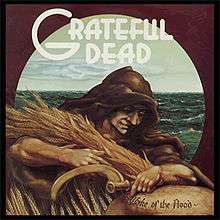Wake of the Flood
| Wake of the Flood | ||||
|---|---|---|---|---|
 | ||||
| Studio album by Grateful Dead | ||||
| Released | October 15, 1973 | |||
| Recorded | August 4–15, 1973 | |||
| Studio | The Record Plant, Sausalito[1] | |||
| Genre | Jam, rock, folk rock, jazz fusion | |||
| Length | 45:34 | |||
| Label | Grateful Dead | |||
| Producer | Grateful Dead | |||
| Grateful Dead chronology | ||||
| ||||
| Professional ratings | |
|---|---|
| Review scores | |
| Source | Rating |
| Allmusic | |
| Robert Christgau | B−[3] |
| Rolling Stone | (not rated) [4] |
Wake of the Flood is the sixth Grateful Dead studio album. It was recorded between August 4–15, 1973, and originally released on October 15, 1973. It was the first release under the band's own label, Grateful Dead Records, after fulfilling their nine-disc contract with Warner Bros. Records. It was their first full-length studio album in nearly three years, since 1970's American Beauty. It was also the first studio album without Ron "Pigpen" McKernan, who had recently died. His absence and new piano player Keith Godchaux's penchants for bebop and modal jazz (rather than McKernan's tendencies toward the blues and soul music) contributed to the band's musical evolution. Godchaux's wife, Donna Godchaux, also makes an appearance as a backing vocalist on the album.[5]
Upon its October 1973 release, the album actually fared better on the pop charts than their last studio album, American Beauty. It peaked at #18, but none of the band's singles were able to reach the national charts.[6]
Background
Recording commenced at the Record Plant on August 4, 1973 and finished on August 15, 1973.[7] For the album, the group mixed several genres and influences from country folk to jazz rock.[8]The band sought to pinpoint the style of their live performances, and replicate it as precisely as possible for the album. With that, the band had a unique perspective. Five compositions, and part of a sixth, had been in the live rotation for between 6 and 14 months. This allowed them to experiment with how the band wanted the tracks to sound for the album.[9] This album has the group's only songwriting and vocal contribution from Keith Godchaux, "Let Me Sing Your Blues Away". This song was never performed live before the album was recorded, and was only performed live six times,[10] all in September 1973 between the recording and release of the album. Hunter and Garcia wrote the majority of the songs, with Weir's only contribution being the epic "Weather Report Suite" that closes the record. The "Prelude" section of this piece had been in the live rotation for 6 shows in 1972-3, but the "Part 1" and "Part 2 (Let It Grow)" were not played live prior to recording the album.
Engineers Dan Healy and Tom Flye recorded and mixed the tracks on 24-track analog at the Lacquer Channel in Sausalito, California. The first vinyl runs were issued from the Monarch Record Mfg. Company pressing plant in Los Angeles. Krieg Wunderlich completed the final mastering from the master tapes in Mobile Fidelity Sound Lab in Sebastopol, California. San Francisco counterculture artist and associate of the Grateful Dead, Rick Griffin, designed the artwork which had a consistent earth tone, backed by a black framing.[11]
The album was released on CD first in 1995 by Grateful Dead Records and Arista before being remastered, expanded, and released as part of the Beyond Description (1973–1989) 12-CD box set in October 2004. The remastered version was then released separately on CD on March 7, 2006, by Rhino Records.[12]
Track listing
All songs written by Jerry Garcia and Robert Hunter and all lead vocals by Jerry Garcia except where noted.
Side One
- "Mississippi Half-Step Uptown Toodeloo" – 5:45
- "Let Me Sing Your Blues Away" (Keith Godchaux/Hunter) – 3:17 (lead singer: Keith Godchaux)
- "Row Jimmy" – 7:14
- "Stella Blue" – 6:26
Side Two
- "Here Comes Sunshine" – 4:40
- "Eyes of the World" – 5:19
- "Weather Report Suite" – 12:53 (lead singer: Bob Weir)
- "Prelude" (Bob Weir)
- "Part I" (Eric Andersen/Weir)
- "Part II (Let It Grow)" (John Perry Barlow/Weir)
Bonus tracks on 2004 reissue
- "Eyes of the World" (live) – 17:02 - Recorded at the Nassau Coliseum in Uniondale, NY on 1973-09-07
- "Weather Report Suite" (acoustic demo) (Weir / Anderson / Barlow) – 12:36
- "China Doll" (outtake) – 4:02
Personnel
|
Grateful Dead
Additional musicians
|
Reissue personnel
|
Charts
| Year | Chart | Position |
|---|---|---|
| 1973 | Pop Albums | 18[13] |
References
- ↑ "Grateful Dead* - Wake Of The Flood".
- ↑ Planer, Lindsay. Wake of the Flood at AllMusic
- ↑ Grateful Dead album ratings at RobertChristgau.com
- ↑ Miller, Jim (January 3, 1974). Wake of the Flood, Rolling Stone
- ↑ "Wake of the Flood - Product Information". cduniverse.com.
- ↑ "Billboard Charts". billboard.com.
- ↑ "Grateful Dead Family Discography". DeadDisc.com.
- ↑ Jim Miller. "Rolling Stones Review". rollingstones.com.
- ↑ Lindsay Planer. "Wake of the Flood - Review". allmusic.com.
- ↑ Deadlists.com. "Search Results". Deadlists.com. Retrieved 12 November 2012.
- ↑ Claude Lemaire. "Enjoy the Music". enjoythemusic.com.
- ↑ "Discography - Wake of the Flood". discogs.com.
- ↑ Strong, Martin Charles (2002). The Great Rock Discography. Canongate. p. 445. ISBN 9781841953120. Retrieved 2 December 2014.